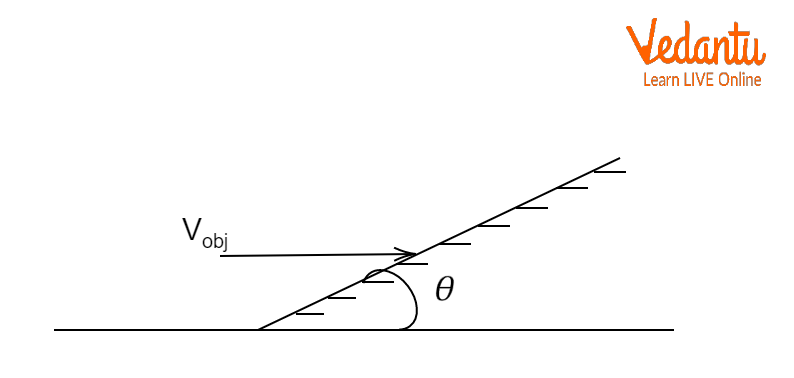




How to Calculate the Velocity of an Image in a Plane Mirror
The velocity of image in plane mirror describes how fast and in what direction the image appears to move when the object, the mirror, or both are in motion. Understanding this is crucial for JEE Main as it connects kinematics with ray optics, a high-scoring topic in competitive exams.
Imagine walking straight towards a mirror on the wall. You will notice the image approaches you, and if you run away, your image also retreats at the same rate. But what if you walk sideways, or the mirror itself moves? For JEE, knowing how to calculate these velocities prepares you for typical exam questions involving reflection and relative motion concepts.
Key Cases for Velocity of Image in Plane Mirror
The apparent speed and direction of an image in a plane mirror depend on how the object and mirror move. Let’s dissect the main scenarios often tested in JEE:
- Object moves perpendicular to mirror's surface
- Object moves parallel to plane mirror
- Object moves at an angle to the mirror
- Mirror itself is moving (parallel or at an angle)
Let’s explore each situation with simple logic and formulae.
Stationary Mirror: Types of Object Motion
When the mirror is fixed, all image movement depends on the object's velocity. Remember, a plane mirror always forms a virtual, erect image located the same distance behind the mirror as the object is in front.
If an object moves perpendicular to the mirror (toward or away):
- The image appears to move at equal speed but opposite direction.
- Formula: vimg = -vobj, where vobj is perpendicular speed.
If you move parallel to the plane mirror's surface, your image copies your motion:
- Same magnitude and direction as object
- No change in distance from the mirror
- Formula: vimg = vobj (parallel component only)
If the motion is at some angle θ to the mirror, break the object's velocity into two components:
- Parallel to mirror: stays the same in the image
- Perpendicular to mirror: direction reverses in the image
Now, combine both using a vector approach:
vimg = vparallel + (–vperpendicular)
For example, if a ball moves diagonally to a mirror, draw the two components, reverse the one facing the mirror, and add up the vectors to get the image's true motion. This vector approach is easy to apply when you practice questions from Vedantu’s JEE modules.
See related concept in object and image velocities.

Plane Mirror Moving: Relative Motion Approach
Now, let’s make it interesting — what if the mirror moves? This brings in relative velocity, a favourite concept in JEE questions. To analyse, always view the object’s speed with respect to the moving mirror, then mirror that effect in the image.
Common situations:
- Mirror moves parallel to its plane: Add mirror and object velocities first (relative to each other), then reverse the perpendicular component for the image.
- Mirror moves perpendicular to plane: Components along the perpendicular might not affect the image, depending on combined relative motion.
- Mirror moves at an angle: Resolve the mirror's movement into parallel and perpendicular, repeat above logic.
For an object with velocity vobj and a mirror with velocity vm (both parallel),
the image’s absolute velocity becomes:
vimg = –vobj + 2vm
This formula is direct and is extremely useful in MCQs, especially when asked about a person running toward a moving lift mirror or a car reversing with a rear-view mirror in motion. Always keep track of directions by drawing quick diagrams — Vedantu teachers emphasise this in their video solutions for a reason!

For additional clarity, see the difference between mirror and lens on the Vedantu JEE Main portal.
Velocity of Image for Inclined Plane Mirror
Occasionally, questions set the plane mirror at an angle to the horizontal. Here, break every velocity (object and mirror) into components parallel and perpendicular to the mirror's surface.
Suppose the object velocity is vo and the mirror makes angle θ with the ground:
- Component along mirror: vocosθ
- Perpendicular to mirror: vosinθ
- Image velocity: vocosθ – vosinθ (vector addition)
You can visualise this with a fast-moving puck gliding toward a slanted mirror — its image doesn’t follow the same straight path as the real object.

Key Formulas and Fast Revision Table
Here’s a concise table of all the formulae, ideal for last-minute JEE Main Physics revisions:
| Case | Image Velocity (vimg) |
|---|---|
| Object perpendicular to mirror | –vobj |
| Object parallel to mirror | vobj |
| Object at angle θ | vparallel – vperpendicular |
| Mirror moves (parallel) | –vobj + 2vm |
| Inclined mirror (angle θ) | vocosθ – vosinθ |
For deeper insight on magnification and crazy image tricks in plane and spherical mirrors, read detailed notes here.
Why Velocity of Image in Plane Mirror Is a JEE Must-Know
Questions on this topic test a mix of vectors, relative motion, and ray optics — high-yield areas in JEE Main Physics. Mastering velocity analysis for mirrors ensures you won’t fumble the kind of MCQ or assertion-reason problems appearing every year.
Vedantu’s JEE materials and online classes reinforce this topic with visual diagrams and past exam questions to help students secure crucial marks efficiently. Knowing when and how to decompose velocities, and apply the sign conventions quickly, is a vital exam hack for every aspirant.
FAQs on Understanding the Velocity of an Image Formed by a Plane Mirror
1. What is the velocity of image formed by a plane mirror?
The velocity of the image formed by a plane mirror is equal in magnitude to the velocity of the object but in the opposite direction, provided the mirror is stationary.
- If the object moves towards the mirror at speed v, the image moves towards the mirror at speed v as well.
- Relative to the mirror, the velocity of image = -v (opposite to object’s velocity).
- Relative to the object, velocity of image = 2v (opposite direction).
2. How do you find the velocity of an image in a plane mirror when the mirror moves?
When a mirror moves, the velocity of image is affected both by the object’s motion and the mirror’s motion.
- If the mirror moves with velocity V and object with velocity v (both towards the mirror), the image velocity = v + 2V.
- If the mirror moves away, the sign of V becomes negative.
- General formula: velocity of image = v (object) + 2V (mirror) (taking direction into account).
3. What happens to the velocity of the image if the object moves towards and away from the plane mirror?
The image velocity mirrors the direction and speed of the object relative to the plane mirror.
- When the object moves towards the mirror at velocity v, the image moves towards the mirror at -v relative to the mirror.
- When the object moves away, image moves away at -v as well.
4. What is the formula for the velocity of image in a plane mirror?
The standard formula for the velocity of image in a plane mirror is:
- If the mirror is stationary: velocity of image = -v (object velocity) (opposite direction)
- If the mirror is moving at velocity V: velocity of image = v (object) + 2V (mirror)
5. Why does the image move twice as fast as the object in a plane mirror?
The image appears to move twice as fast because the total change in distance between the object and its image is double the object's movement.
- When the object moves towards/away at v, the image moves at -v (relative to the mirror).
- Relative to the object, the image approaches/recedes at 2v as both distances change simultaneously.
6. If an object approaches a plane mirror at 5 m/s, what is the velocity of its image relative to the object?
The velocity of the image relative to the object is 2 × 5 m/s = 10 m/s in the opposite direction.
- Object velocity (v) = 5 m/s
- Relative velocity (image w.r.t. object) = 2v = 10 m/s
7. In which direction does the image move when the mirror moves towards a stationary object?
If the plane mirror moves towards a stationary object, the image also moves towards the object, but at double the speed of the mirror.
- Mirror velocity (V) = towards object
- Image velocity = 2V (relative to mirror)
8. What are some common numericals asked on velocity of image in plane mirrors?
Popular numericals on velocity of image in plane mirrors often involve calculating the speed and direction of the image when:
- An object moves towards or away from a stationary mirror
- Both the object and mirror move (either towards or away from each other)
- Calculating the image speed relative to either the mirror or object
9. Can the velocity of image ever be greater than that of the object in a plane mirror?
Yes, the velocity of the image relative to the object can be greater, especially in certain cases:
- If the mirror also moves, velocity of image = v + 2V
- Relative velocity between image and object can be up to 2v
- Both image and object appear to approach/recede faster
10. What is the difference between real and virtual image velocity in a plane mirror?
Plane mirrors always produce virtual images, and their velocity is determined by object and mirror motion.
- Virtual image velocity in a plane mirror is given by formula: v (object) + 2V (mirror)
- Real images are not formed by plane mirrors (except in rare cases with multiple mirrors)
























